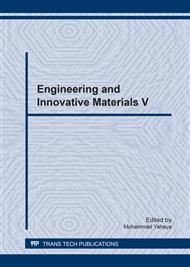p.19
p.25
p.30
p.36
p.45
p.51
p.56
p.65
p.71
Effect of ENR Contents on Cure Characteristic and Properties of NR/ENR/EVA Foam
Abstract:
This research studied foaming of natural rubber (NR), epoxidized natural rubber (ENR) and ethylene vinyl acetate copolymer (EVA) blends vulcanizate. The contents of NR/ENR/EVA investigated were 60/10/30, 70/10/20, 50/20/30 and 60/20/20 to keep NR based to 70 and 80 % by weight whereas EVA contents were 20 and 30 % by weight. ENR used in this research was ENR 50. The content of ENR was varied as 10 and 20 % by weight with restpect to total polymer content. The Efficient vulcanization and peroxide systems were used for rubber vulcanization in order to cure both rubber and EVA. Oxydibenzenesulfonyl hydrazide (EW or OBSH) was used as foaming agent. The results showed that rubber blends with 20% ENR tended to show better compatibilization between NR and EVA. The viscosity of rubber blend which indicated by minumum torque was increased with the content of ENR. Cell size of rubber blends foam containing ENR 20 % showed rather normal distribution than ENR 10%. Foam with high content of NR based rubber showed slightly higher density than the other systems. Tensile properties of rubber blends foam were dependent upon NR based contents and compatibility between NR and EVA. Rubber blends foam with high ENR content showed higher specific secant modulus. The specific tensile strength and elongation at break were slightly inferior. The specific tear resistance of the rubber foam was independent on compatibility. High EVA content reduced both specific compressive modulus and compressive strength of the foam. For the foam that contained EVA domain showed permanent deformation and hence high in compression set. Compatibilized rubber blend foams and the foam with high EVA possessed low ball rebound resilience.
Info:
Periodical:
Pages:
45-50
Citation:
Online since:
March 2017
Price:
Сopyright:
© 2017 Trans Tech Publications Ltd. All Rights Reserved
Share:
Citation:


